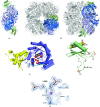Structure of Rubisco from Arabidopsis thaliana in complex with 2-carboxyarabinitol-1,5-bisphosphate
- PMID: 29372894
- PMCID: PMC5786004
- DOI: 10.1107/S2059798317017132
Structure of Rubisco from Arabidopsis thaliana in complex with 2-carboxyarabinitol-1,5-bisphosphate
Abstract
The crystal structure of ribulose-1,5-bisphosphate carboxylase/oxygenase (Rubisco) from Arabidopsis thaliana is reported at 1.5 Å resolution. In light of the importance of A. thaliana as a model organism for understanding higher plant biology, and the pivotal role of Rubisco in photosynthetic carbon assimilation, there has been a notable absence of an A. thaliana Rubisco crystal structure. A. thaliana Rubisco is an L8S8 hexadecamer comprising eight plastome-encoded catalytic large (L) subunits and eight nuclear-encoded small (S) subunits. A. thaliana produces four distinct small-subunit isoforms (RbcS1A, RbcS1B, RbcS2B and RbcS3B), and this crystal structure provides a snapshot of A. thaliana Rubisco containing the low-abundance RbcS3B small-subunit isoform. Crystals were obtained in the presence of the transition-state analogue 2-carboxy-D-arabinitol-1,5-bisphosphate. A. thaliana Rubisco shares the overall fold characteristic of higher plant Rubiscos, but exhibits an interesting disparity between sequence and structural relatedness to other Rubisco isoforms. These results provide the structural framework to understand A. thaliana Rubisco and the potential catalytic differences that could be conferred by alternative A. thaliana Rubisco small-subunit isoforms.
Keywords: 2-carboxyarabinitol-1,5-bisphosphate; Arabidopsis thaliana; Rubisco; carbon fixation; isoforms; merohedral twinning; rbcS multigene family; ribulose-1,5-bisphosphate carboxylase/oxygenase.
Figures


References
MeSH terms
Substances
Grants and funding
LinkOut - more resources
Full Text Sources
Other Literature Sources
Molecular Biology Databases

